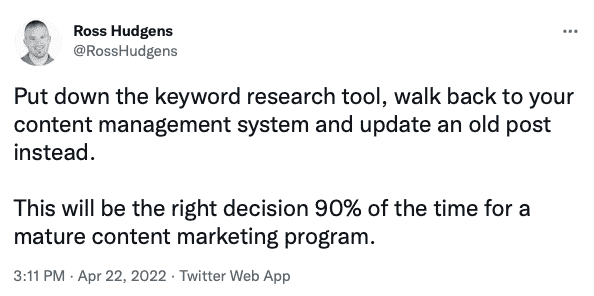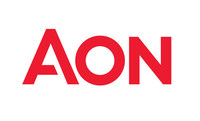17 content optimization mistakes affecting ROI

Hint: proper content optimization is more than just adding in a few keywords and creating a FAQ section.
Even Ross Hudgens confirms it to be a mature content marketing strategy.

That’s why we now see people adding content optimization to their budget requests.

I’m not asking you to spot the mistake in the above tweet but to see a significant amount dedicated to content optimization.
Now that SEOs have the budget for content optimization and know how to optimize content (even for featured snippets), let me showcase the mistakes that happen directly or indirectly when planning and implementing content optimization.
I was able to find 17 of them. Let’s get straight to it.
1. Missing out on the audience research
The biggest mistake while optimizing content is not considering for whom this content needs to be. If the audience reading your content is not right, how can you expect ROI?
Every business and industry/segment has different audiences that read the content.
For example:
The publishing industry
A publishing site like Search Engine Land would target the audience such as:
- SEOs at all levels (entry, intermediate, experienced, managerial) to learn and inspire
- PPC professionals at all levels (entry, intermediate, experienced, managerial) to learn and inspire
- Business owners looking to market their SEO or PPC related products
Service industry
A marketing agency like Missive Digital would target the audience such as:
- Business Owners of SaaS, IT, and B2B companies
- Marketers at all levels (entry, intermediate, experienced, managerial) to learn and inspire about marketing
Product segment
A talent-hiring platform like Codemonk would target the audience such as:
- Developers of all technologies looking for jobs
- Project heads of global enterprises looking to hire remote talent
We decided to write the content showcasing the behind-the-scenes story of every top online fashion brand and their life-changing decisions.
The result is in front of you. We still own that featured snippet.
You can optimize your content for a specific audience and get a much higher ROI. It doesn’t matter what keywords you use, as long as they’re relevant to the people who will be reading them!
2. Disdaining the user’s reading intent
Being an SEO, you care a lot about user search intent; what goes missed is their reading intent – the “Why” of a person reading the content.
For example, this week, we optimized content for “ReactJS developer skills.” When we received the blog for optimization, we saw it had the section, “What is ReactJS and its benefits.”
My team member quickly messaged me about whether we should have that section considering the topic and the users’ reading intent.
We removed that section before it goes live, as we should understand that people coming to read about ReactJS developer skills are very well aware of the basics of ReactJS. You don’t need to waste their time and effort there.
Before optimizing, think twice about why a person would continue reading your content, improving content metrics.
3. Not analyzing the right data in Search Console
Today, every SEO is looking for quick hacks. Here is one I found recently,
 100vw, 594px” data-lazy-src=”https://searchengineland.com/wp-content/seloads/2022/06/Screen-Shot-2022-06-14-at-1.29.43-PM.png” /></figure>
<p>Aisha Preece has suggested a great hack, but we need to choose those high-impression queries carefully.</p>
<p>Here is a list of the top 10 queries on Google Search Console (GSC) to optimize the content, “X Benefits of Full Stack Development.”</p>
<figure class=)
The highlighted user search queries have the highest impressions. If we choose them to optimize the content for them, we end up making a mistake that would cost not just our content creation but optimizing and link-building effort, leading to negative ROI.
Why? Because the user’s searching and reading intents behind those keywords won’t match the topic that we are optimizing.
The people searching information for the query “hire full stack developer” are not looking to understand the benefits of full stack development but to hire a developer doing that.
4. Forgetting about analyzing user behaviors
Most content optimization sticks to looking at GSC and optimizing keywords in any way possible.
But ROI doesn’t stick to keyword rankings, and it goes beyond traffic and conversions.
While conversion is still the most significant ROI metric, most SEOs skip looking at conversion optimization tools to see how people behave on the content they’re looking to optimize.
Forget conversions if that’s too high. Think of content metrics such as engagement rate, engaged sessions per user, and average engagement time. The content you optimize should be improving these metrics too.
You need to look at what makes your audience read the content more, whether they find images interactive, whether that highly creative pop-up is annoying and much more.
Unless you know these things, you only optimize for keywords, not conversions. And honestly, better keyword ranks don’t guarantee business. Avoid making such a content optimization mistake.
5. Not analyzing your competitors thoroughly
I often see SEOs considering the following things while doing a competitor analysis for content optimization.
- How many words they have written
- What headings they have used
- The keywords they rank for
- The backlinks (but least important)
- The media they have added
The biggest mistake we make here is looking at what our competitors have added. We should be looking at what they haven’t. After all, outperforming them would drive excellent results.
For example, when we were doing competitor research to optimize the content on “top fintech apps,” everyone talked about the fintech app. None of them wrote about which type of fintech app it is.
We added that line for every app in the list, and we got the featured snippet for the most competitive and high-impression keyword.
 100vw, 256px” data-lazy-src=”https://searchengineland.com/wp-content/seloads/2022/06/FTMqoMqaAAEFxxA.png” /></figure>
<p>Note: Content optimization structure example on Google Docs.</p>
<p>Like any other task, having a structure for content optimization eliminates any chances of missing out on an important aspect and improves how efficiently it’s implemented.</p>
<h2>7. Skipping the tech content audit</h2>
<p>What if the optimized content has a poor user experience on the mobile site? The content has media that take years to load. Navigating from one page to another is a puzzle for the user.</p>
<p>Do you think such issues will sustain the user on the site for more time? Of course, not.</p>
<p>How can you expect that content to improve performance metrics?</p>
<p>Get the technical audit done. If you have done it already, that saves time.</p>
<p>But, in a case like ours, when you have got a project only for content optimization, I would suggest you follow the below <a href=) tech content audit steps by Tory Gray and Tyler Tafelsky.
tech content audit steps by Tory Gray and Tyler Tafelsky.
- Ensure your JavaScript content is fully accessed and rendered using SEO Spider Software.
- Audit core web vitals (as you already have access to GSC) and optimize for page speed using the Page Speed Insights tool or the Chrome Web Vitals Extension (to save some time).
- Audit index bloat and keyword redundancies, and prune mindfully using sitemaps.
- Determine (and improve) pages where you’re losing users using Google Analytics.
- Leverage content gaps inspired by competitors and keyword data using an SEO tool
- Consider non-SEO segments and overall conversion value using the SEO Spider tool integrated with Google Analytics API.
If the doctor doesn’t know your problem, it would be difficult to suggest the medication. And, you know the implications of incorrect medication, right?
8. Mapping the irrelevant keywords
This is one of the most common content optimization mistakes I have seen, experienced, and rectified.
Even at Missive Digital, we invest a considerable amount of time training new joiners on how they don’t have to choose money keywords when optimizing a blog and vice versa.
If you go back to your past and current optimization docs, you will see a mix of both blog and money keywords to be used in the blog.
With this, you’re confusing search engines on which page to give importance for ranking the target queries and also inviting keyword cannibalization issues.
With such issues, the blog page won’t be able to educate the audience, and the money page won’t convert. Ultimately, your content optimization effort would not result in a positive ROI.
9. Choosing a non-user-friendly content flow
How do you say if the content has a non-user-friendly flow? By comparing the topic and its users’ reading intent with the content flow.
For example, let’s take the blog example, “The best smart TVs to buy in 2022.”
Adding new section
You can add a new section if you feel the content is incomplete for a user to get enough value. Here is how you can suggest them.
Writing a new blog and cross-link with each other.
Sometimes, you create a guide-like content where you have different sections, which can be explained in detail but not in that guide. In such cases, you need to write a separate blog and use its summary in that guide-like content.
With this kind of content optimization, you get the opportunity to rank for another blog and pass the internal link juice to the guide-like content and vice versa.
Removing unnecessary or stale content
Content optimization is certainly not only about adding new things but even removing the things that can hamper the actual ROI. The way we think, removing zero-performing content can drive great results.
Dana DiTomaso says in a blog post by Andy Crestodina,
“Sometimes you’ll find several blog posts on the same topic but they’re all mediocre, so none of them rank. If the content is still something you want to keep, then combine them into a much better post and redirect the old posts to the new one.”
Following are the scenarios where removing the content makes more sense:
- When your content has less than 10 or 20 impressions a quarter.
- When most of your content has definitions and benefits to refer to. Not every content needs that.
- Trends, best practices, and quick hacks change from time to time.
Changing the length of a section
As content curators, we don’t believe in more extensive introductions or brief explanations in a how-to guide. In such cases, we suggest changing the length of the section considering the content metrics.
</li>
<li>Named appropriately (and not just logo-1.jpg)</li>
<li>Described properly with proper ALT attribute (and not just logo-1)</li>
</ul>
<p>I shared more on my strategy for optimizing image ALT attributes in <a href=) this presentation.
this presentation.
13. Being strict on external links
Either people don’t put external links, or if they put, they always consider them making “nofollow.”
Here is what the Google guidelines have on the “nofollow” attribute,
“Use this attribute for cases where you want to link to a page but don’t want to imply any type of endorsement, including passing along ranking credit to another page.”
I’m clueless when I hear that.
If we don’t optimize our content for the search engines, don’t do it for plugins as well.
15. Over optimizing content
Thankfully, we haven’t seen so many blogs with such a mistake.
And that’s why we don’t even have it on our checklist earlier.
But while I was writing this blog, one of my team members asked if we could tell our client that they had stuffed a keyword.
That’s when I decided to add it to this comprehensive list of content optimization mistakes.
There is no keyword density to focus on today, but the keyword should be added naturally and not in every sentence.
Readers are smart enough to identify if you’re faking what you’re saying when you stuff keywords. If users leave your site with such an experience, you lose them forever.
So, just stop it if you’re even thinking about it.
16. Not thinking about building links
I have experienced and heard a lot of case studies where a site is ranking without building links.
But what about conversions, thought leadership, and brand authority? That comes with building links.
Be it any business (even my agency), mostly leads convert from the repeat visitors.
They have visited your website, researched your business on different platforms, and then come to your website again to put the inquiry.
For every content you create and optimize, you should think of distributing it on the right platforms to make the most out of it.
As I said earlier, ranks don’t guarantee conversions, but the authority does.
17. Skipping the performance monitoring
Last but not the least mistake of content optimization is not monitoring the performance of the content optimized.
How will you come to know if the optimization worked? Whether it drives more engagement or conversions? Content metrics come into the picture. You can use various SEO tools, Google Analytics, Search Console, SEO spider software, and more to monitor the content performance.
But, what’s more important is how often you track it.
We have this tracker, where we monitor the performance every week after the content is updated as per the optimization suggested.
Use my MOM (Monitor -> Optimize -> Monitor) approach to improve results. I coined this approach during my talk on boosting organic traffic using featured snippets at Whitespark Local Search Summit 2021.
Optimize your content wisely.
The above 17 content optimization mistakes help you stick to what is suitable for your audience and brand more than the search engines. After all, publishing content is only 20% of the task. The rest, 80%, is optimizing it to own featured snippets.
Go, and download this infographic to circulate among your team and friends for them to keep handy.


